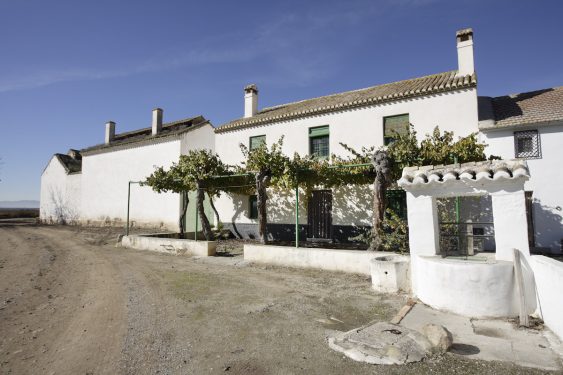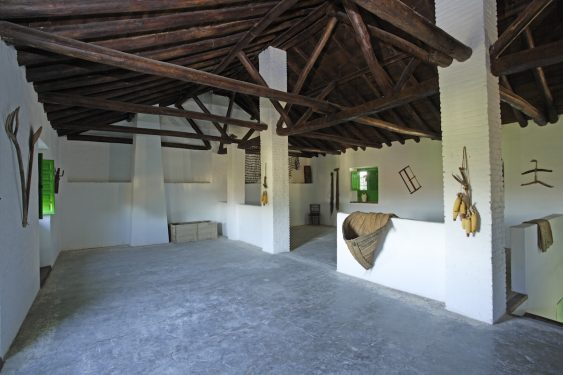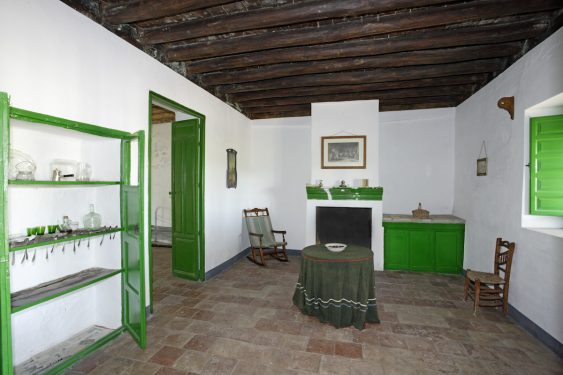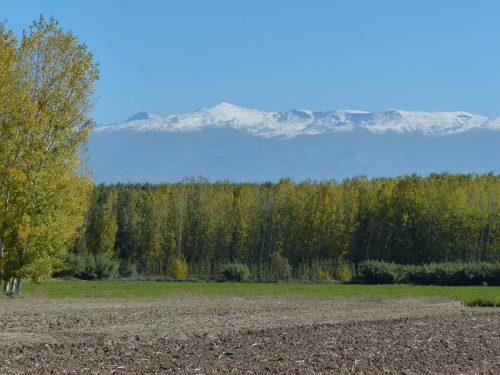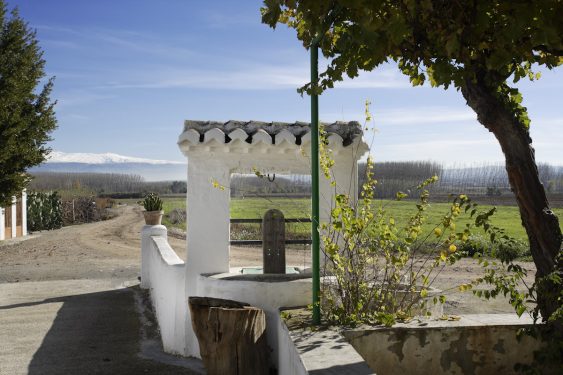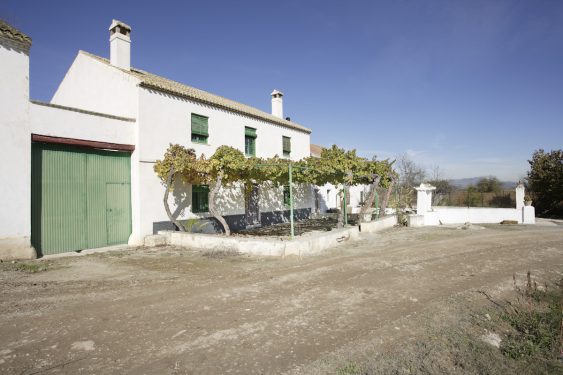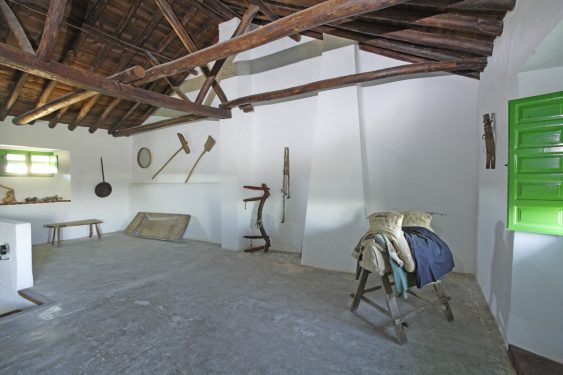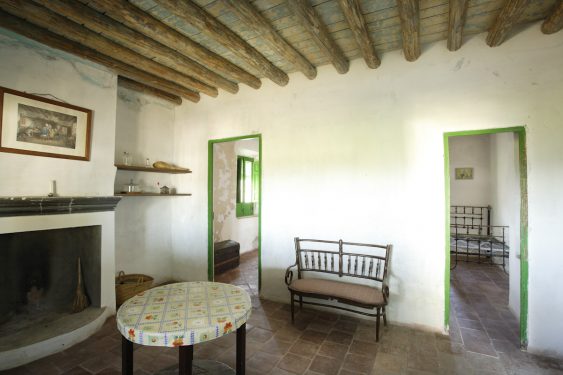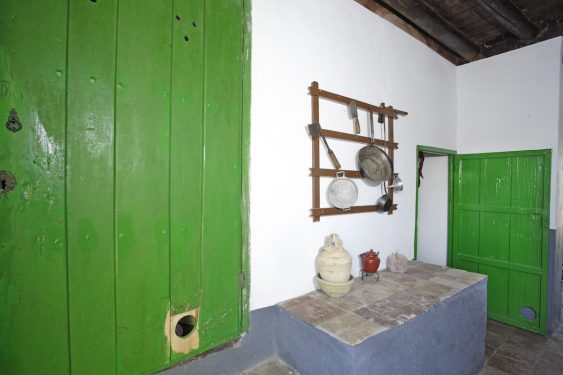Farmhouse and lands belonging to the term of Pinos Puente where Lorca’s father made his fortune and where the poet lived his first “artistic amazement”.
The farmhouse and the Daimuz Bajo estate, in the Valderrubio valley but belonging to the municipality of Pinos Puente, are linked to Federico García Lorca by two apparently contradictory facts: first, it was the place where the definitive enrichment of his father took place, and, second, the almost sacred territory where the “first artistic amazement” that moved the future poet took place and where his youthful creative sensibility unfolded.
There, in that idyllic setting populated by lush poplar groves, the poet spent the best years of his childhood and youth: among its poplar groves and next to the fountains and riverbanks he tried his first poetic attempts that would later form part of volumes such as Book of Poems, Songs and Suites and, after some time, in other mature works such as Divan del Tamarit, and in dramatic works such as Blood Wedding or The House of Bernarda Alba.
“My first emotions are linked to the land and the work in the fields. That is why there is in my life an agricultural complex, as psychoanalysts would call it.”
Daimuz (“farmhouse of the cave” according to the Arabic derivation) is formed by farmlands located near the confluence of the river Cubillas and Acequia Grande that extend around the farmhouse and beyond. The building, which has undergone numerous transformations, consists of a courtyard of about 400 square meters that still retains industrial remains of its last use for tobacco processing. The farm, located on the road to Láchar, just two kilometers from Valderrubio, and which is reached by a lane after passing a watercourse, was acquired by Don Federico García Rodríguez in 1895. At present the farm, which belongs to the municipality of Pinos Puente, covers only 16 hectares of farmland and its future envisages more cultural than agricultural use and can be visited aboard a tourist train chartered by the City Council.
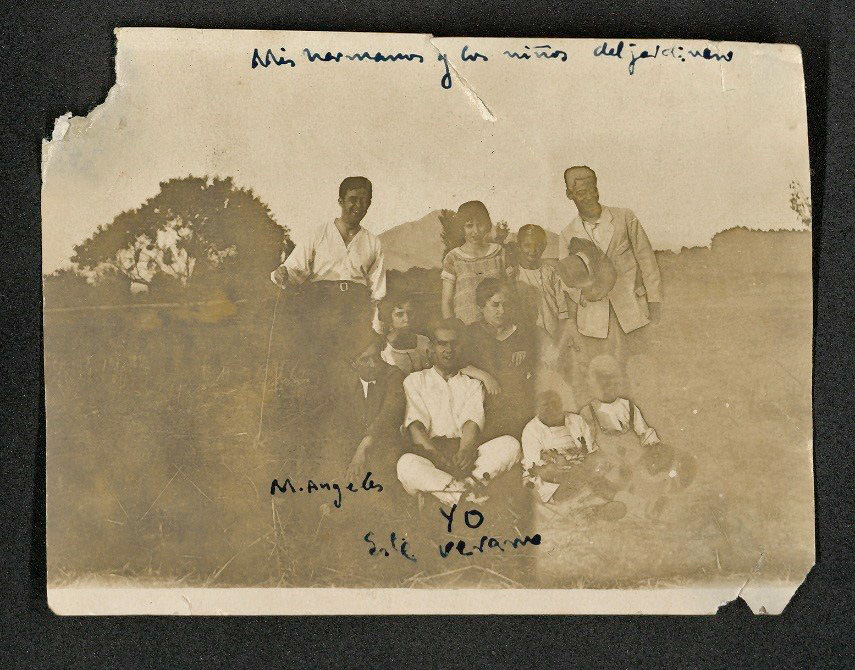
Federico García Rodríguez was among the first in the village to sell the Fuente Vaqueros fields to buy non-irrigated land. “He bought a lot in a dry area that gave nothing, but was next to the Cubillas River and the Acequia Grande. He made an irrigation plan (…). He and a Daniel turned that dry area into the beautiful farmhouse of Daimuz Bajo with which my father earned a lot of money”. The sale of the property allowed him to invest in projects that then seemed risky, such as the sugar beet industry, recounts Isabel García Lorca.
The García Lorca family moved their residence to Valderrubio between 1906 and 1907 so that the father could better attend to his business, but only stayed for two years, until 1908, when they all moved to their first home in Granada, on the Acera del Darro. The move to Granada did not take their rural fondness away from them. Every summer the family went to Valderrubio, after the feast of Corpus Christi, to participate in the threshing and other agricultural work.
The relationship of Federico and Francisco with Daimuz has the flavor of primal experiences. Francisco writes: “The first memories of my life are of Daimuz, as well as the first image I keep of myself, Federico and my parents, which has been relived so many times later that I can still see it clearly now”.
Federico’s youthful experiences are also related to Daimuz, solid memories that he never got rid of and that he used to bring up, as an adult, in the most unexpected places and circumstances. On March 10, 1934, in an interview with the journalist José R. Luna, of the magazine Crítica of Buenos Aires, Lorca reveals that it was in Daimuz where he experienced his first “artistic amazement”: “I love the land. I feel linked to it in all my emotions. My most distant memories as a child have a taste of the land. The bugs of the earth, the animals, the peasants, have suggestions that reach very few. I capture them now with the same spirit of my childhood years. Otherwise, I would not have been able to write Blood Wedding. This love for the land made me realize my first artistic expression (…). It was around 1906. My land, a land of farmers. It had always been ploughed by the old wooden ploughs, which barely scratched the surface. And in that year some farmers acquired the new Bravant ploughs – the name has remained forever in my memory – which had been awarded for their efficiency at the Paris Exhibition of 1900. I, a curious child, followed the vigorous plough of my house all over the field. Once the plow stopped. They had stumbled over something solid. A second later, the shiny steel blade pulled a Roman mosaic out of the earth. It had an inscription that I do not remember now, although I do not know why the name of the shepherds Daphnis and Chloe comes to my memory (…). That, my first artistic amazement, is linked to the earth. The names Daphnis and Chloe also have the flavor of earth and love. My first emotions are linked to the land and to the work in the fields. That is why there is in my life an agricultural complex, as psychoanalysts would call it”. Although his brother Francisco doubts the finding, there is evidence of the appearance of Roman coins and pottery remains in the farmhouse lands.
Among the many characters linked to Daimuz perhaps the best known is the “Shepherd friend”, the man of confidence of Don Federico who guided him in the care and development of the business linked to the farmhouse.
The Shepherd friend recommended that he let his brothers choose the land on condition that he reserved for himself that below the boundary. This allowed him to unify the land, plough the wastelands and increase irrigation with the channels that the Shepherd himself designed.
Federico knew his “Shepherd friend” well. He appears illuminated by nostalgia and the proximity of death in a youthful prose where he reconstructs one of his first memories: “The kitchen was filled with cigar and wood smoke and the figures looked like dreadful shadows with the flames. I used to fall asleep caressed by my Shepherd friend and I sensed his voice saying in my sleep: ‘Quiet!’ and then one of his sons would carry me in his arms, quickly, to my mother who pressed me against her chest and covered me with kisses (…). Until one day he did not go, he was already very old and had a high fever… my parents were very alarmed and I was afraid for his life… the doctor said that he was very ill and that he would not recover from that illness… My father then sent for the doctors of the nearby towns, but they all said the same thing. I went to visit him because he was asking for me… It was as if he were dead, with his mouth half open and his eyes closed. When I came in, he opened them and when he saw me, he smiled as sweetly as he used to. My mother picked me up and sat me on the bed. He sat up, helped by a niece and he caressed me for a while, running his hands over my face. Then he kissed my hand, and with a loud sigh he let himself fall on the pillows”.
Another of the usual characters that appeared in Daimuz was Nicasio, an itinerant painter of doors and windows who, in addition to the tools of his trade, carried an accordion. That figure is linked to the memory of Francisco García Lorca: “On this occasion he was commissioned to do some work in the farmhouse and, as the family was gathered in the room at the entrance, which served as dining room and living room, Nicasio, the musician painter, played his accordion. Perhaps it was my father who said: `Paco, dance¨. Without following the rhythm of the music very well, I began to run to one side with an uncertain step, from one wall of the room to the other, amidst the laughter of the family. I remember, if I have not recreated it from a later recollection, that my brother was sitting next to Nicasio, on the steps leading to the upper chambers. Federico was laughing out loud”.
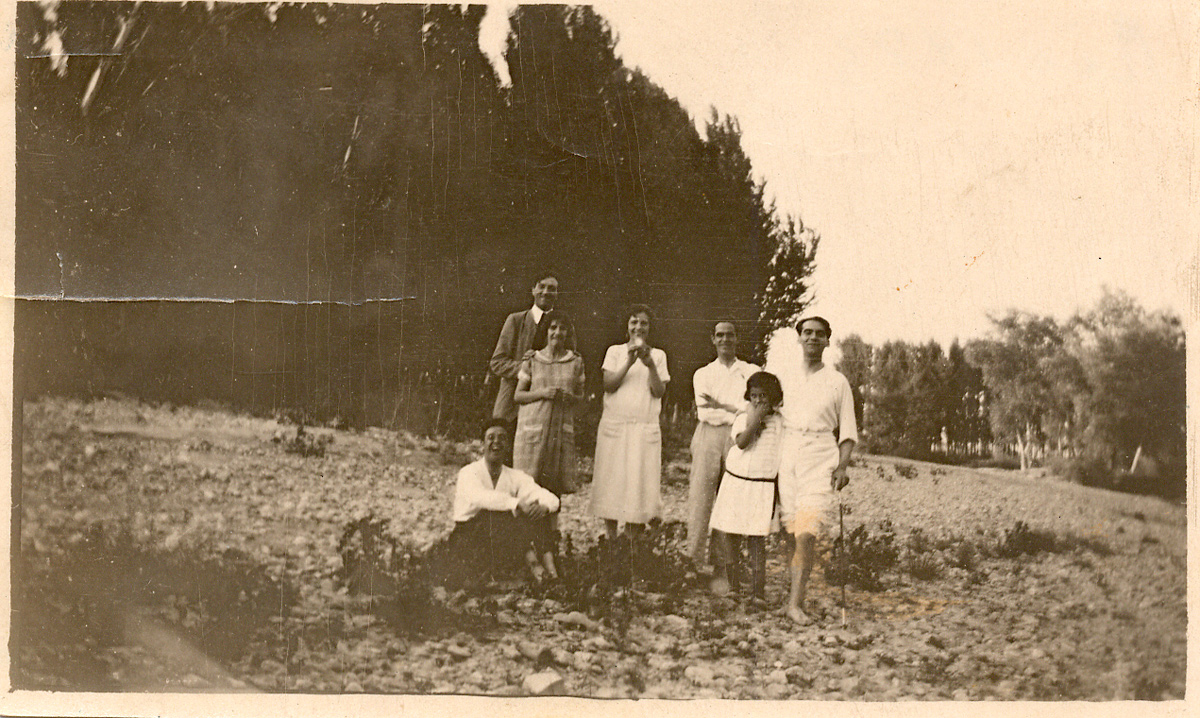
Federico inicial’s literary work is riddled with references to the life of La Vega. In the Book of Poems (1921), for example, there are direct allusions to children’s games and folk songs of the land in poems such as Sad Ballad, Santiago, Interior Ballad (“Cold, cold / like the water of the river”).
Those contained in Suites are short poems, written between 1920 and 1923, at the Students’ Residence or at Asquerosa (Disgusting), during the summer. In July 1920, at the house in Asquerosa, Lorca wrote several suites whose subject matter is again the loss and ultimate frustration of lost love or childhood. In Moments of Song, for example, the same elements and the same subject matter of Book of Poems appear, but their poetic expression is totally different.
Songs, published in 1927 but written between 1921 and 1923, is also composed under the direct influence of the Vega as a primordial and decisive place. The presence of the peasant environment of Asquerosa (Disgusting) is especially noticeable in some songs: “Mi sombra va silenciosa [My shadow goes silently] / por el agua de la acequia [through the water of the irrigation channel]” (Debussy); “niño [child], / que te vas a caer al río! [you’re going to fall into the water!]” (Narciso); “en el soto [in the undergroqth], / los alamillos bailan [the small poplars dance] / uno con otro. [With each other.]” There is a poem dedicated to “Irene García. Maid” and recreations of children’s games and songs.
In January 1935, a year and a half from his assassination, Lorca again confirms the weight that his childhood spent in the territories of the Vega still has on his work. In February 1934, in an interview in La Voz de Madrid newspaper with the journalist Ángel Lázaro, Proel, he declares: “All my childhood. Shepherds, fields, sky, solitude. Simplicity, in short. I am very surprised when they believe that those things in my works are my daring, audacity of a poet. No. They are authentic details, which seem strange to many people because it is also strange to approach life with such a simple and impractical attitude: to see and hear: such an easy thing, right?
The documents indicating the ownership of the Daimuz Farmhouse dates back many centuries. The most remote ones were written in Arabic which guaranteed that its origin was not related to the disentailment of Mendizábal and the easy enrichment at the expense of the property of the Church.
Federico and Francisco spent many hours reading all those documents, indeed, they made those examinations a form of pastime. “How many times Federico and I entertained ourselves in looking at those documents whose letters sometimes made it very difficult to see how the names of the pillars of the holders changed; sometimes as if they were the ladies of a comedy: Doña Sol, Doña Elvira, Don Lope; and more archaic like Doña Mencía”, recalls Francisco García Lorca.
Por el río van mis ojos,
[My eyes go]
por el río…
[down the river …]
Por el río se va mi amor,
[My love goes]
por el río
[down the river]
(Mi corazón va contando
[(My heart is counting]
Las horas que está dormido.)
[the hours that he is asleep.)]
El río trae hojas secas,
[The river brings dry leaves,]
el río…
[the river …]
El río es claro y profundo.
[The river is clear and deep.]
el río…
[the river…]
(Mi corazón me pregunta
[(My heart asks me]
Si puede cambiar de sitio)
[if it can change places)]
- Isabel García Lorca. My Memories. Tusquets. Barcelona, 2002.
- Federico García Lorca. Poems of La Vega. Selection by Javier Alonso Magaz, Luis García Montero and Andrea Villarrubia. Galaxia Gutenberg. Barcelona, 2014.
- Federico García Lorca. Word of Lorca. Complete statements and interviews. Edited by Rafael Inglada and Víctor Fernández. Malpaso. Barcelona, 2017.
- Francisco García Lorca. Federico and his world. Alianza Tres. Madrid, 1990.
- Ian Gibson. In Granada, his Granada. Plaza y Janés. Barcelona, 1989.
- Ian Gibson. From Fuente Vaqueros to New York. Grijalbo. Barcelona, 1985.
- José Mora Guarnido. Federico García Lorca and his world. Losada. Buenos Aires, 1958.
- Lorca´s location
- Cortijo Daimuz
- current location
- Cortijo Daimuz
- ADDRESS
- Camino Láchar-Valderrubio
